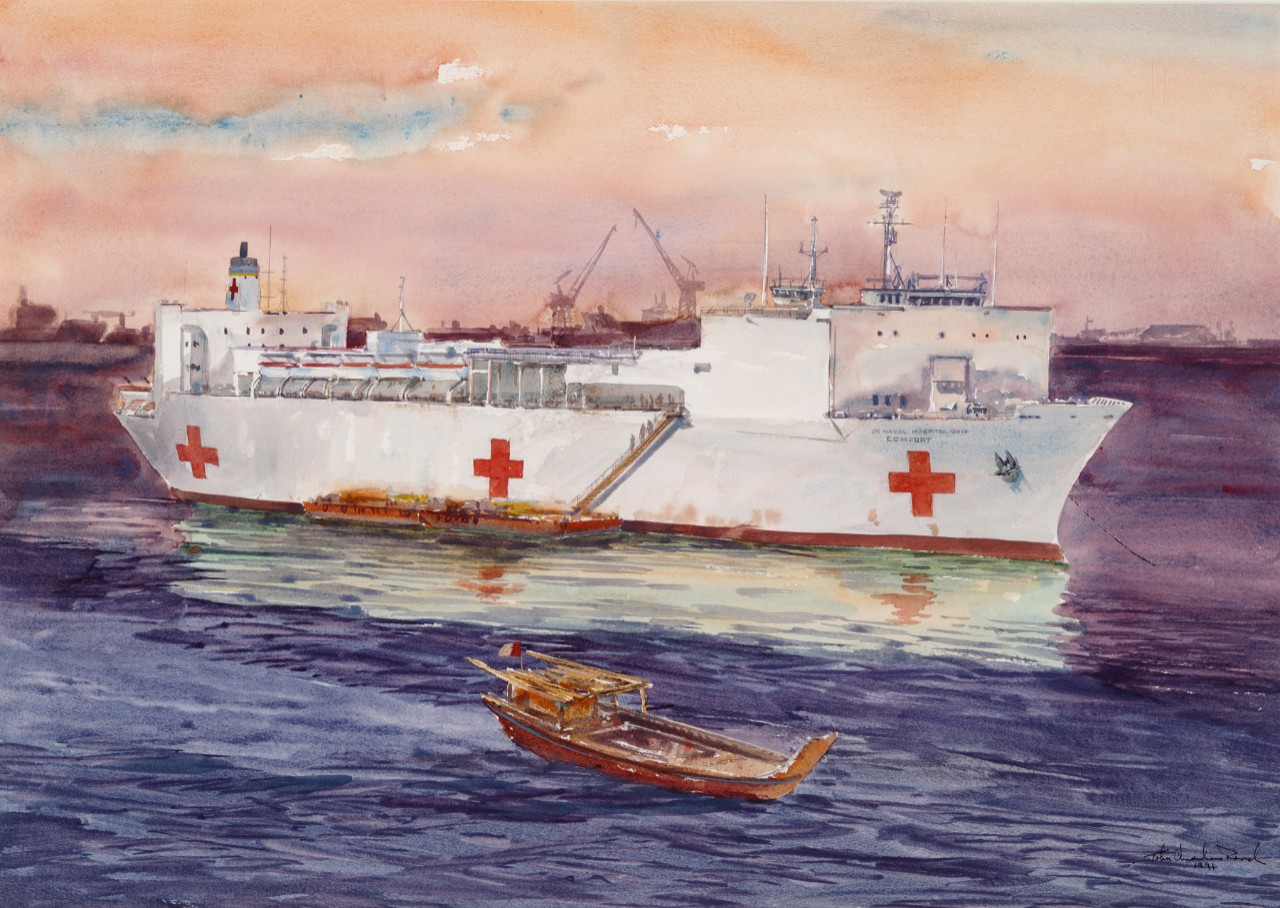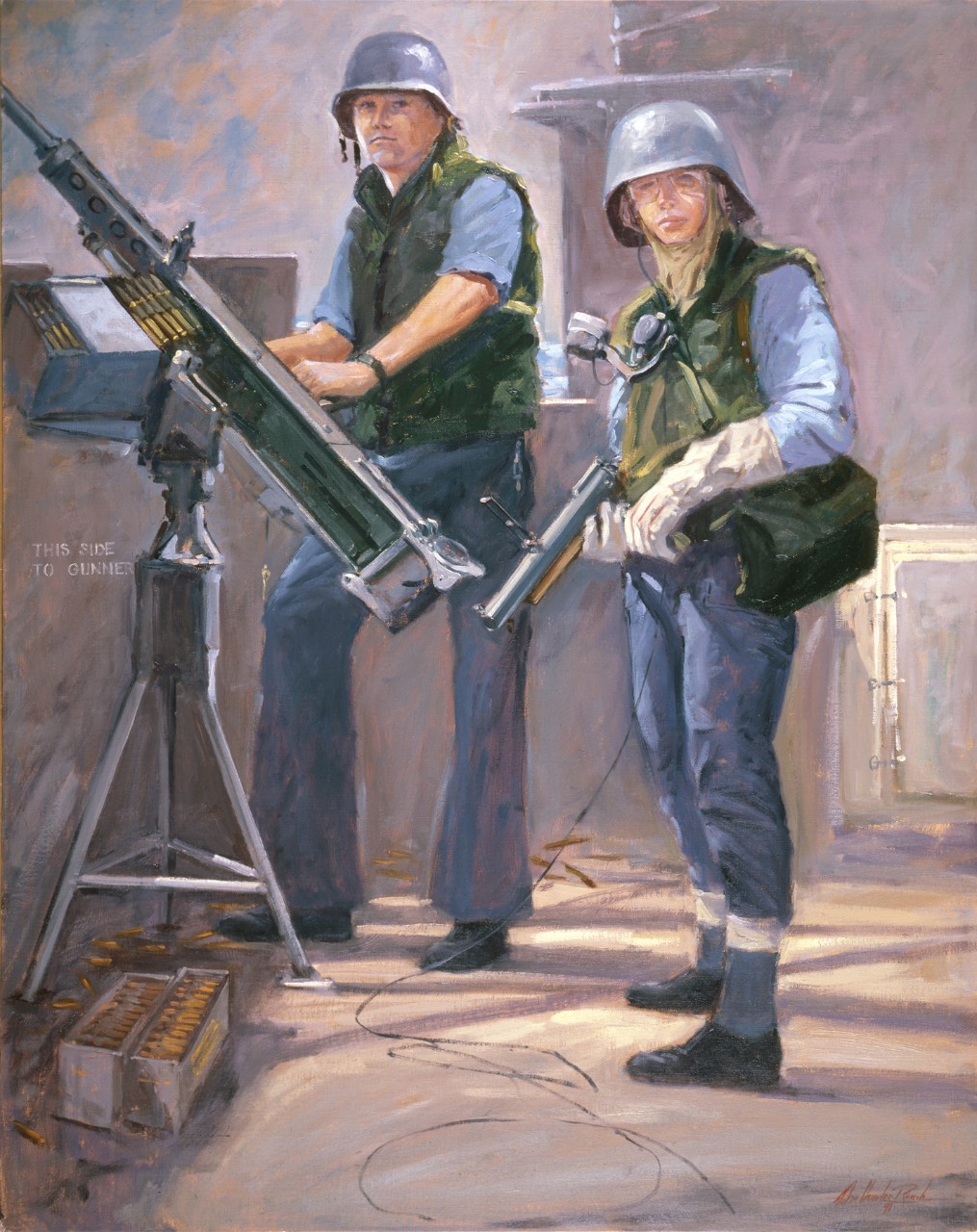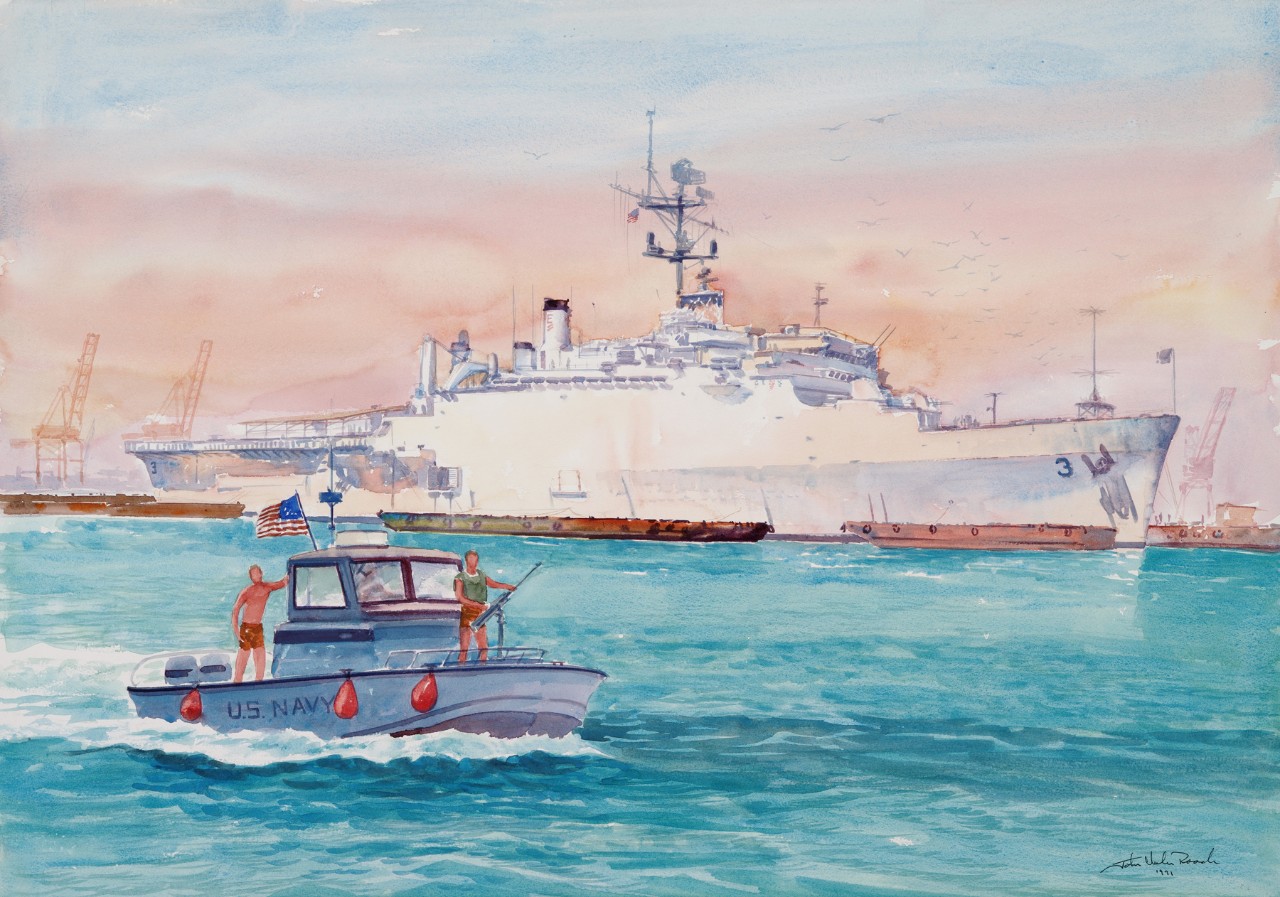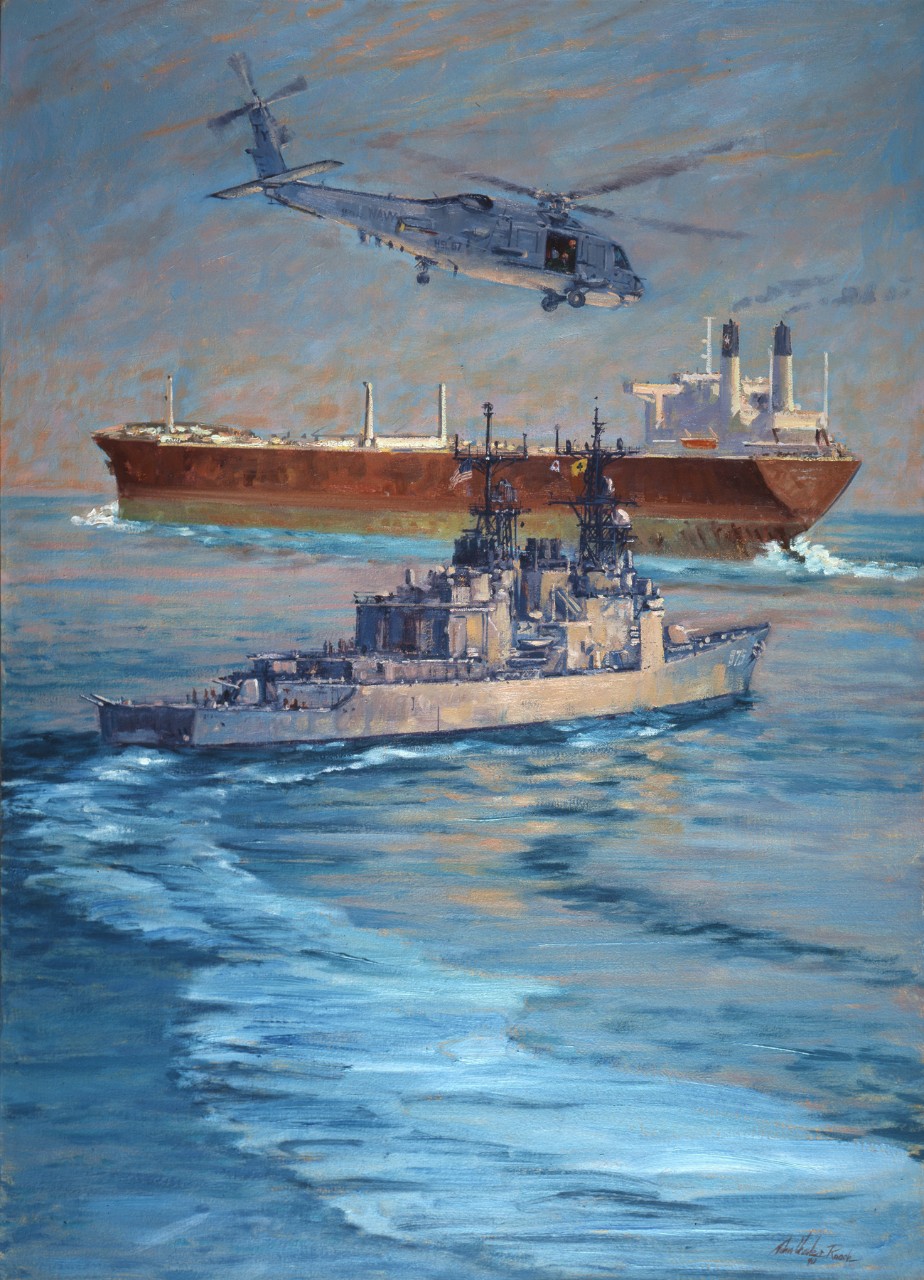H-053-3: Operation Desert Shield, September 1990
Operation Desert Shield/Desert Storm—Part Two: September 1990
This ongoing series is a departure from my normal H-grams in that this is a personal recollection. I was the “Iraq Subject Matter Expert” on the intelligence staff of Commander, U.S. Naval Forces Central Command, for the entirety of Operations Desert Shield and Desert Storm, serving under Vice Admiral Hank Mauz and Vice Admiral Stan Arthur. I first wrote this a number of years after the fact, but I kept it true to what I believed and understood to be true at the time. So, my dim view of joint operations as conducted during Desert Storm (which held the Navy back from making maximum contribution to the war) and U.S. Central Command, particularly the intelligence support architecture, will be readily apparent. My penance for this heresy was to spend 12 of the next 21 years in joint commands, including three years as commander of the U.S. Central Command Joint Intelligence Center, in which I had the opportunity to see vast improvement in U.S. joint operations.
Desert Storm Deployment, USS Blue Ridge (LCC-19), August 1990–June 1991 (Operation Desert Shield, September 1990–January 1991)
Mina Salman, Bahrain, 1 September 1990
USS Blue Ridge made a triumphal entry into Bahrain. The air conditioning had already broken and my stateroom was over 95 degrees. Prepared to be greeted by terrorists on the dock, the .50 caliber machine guns were mounted and the quarterdeck watch was armed to the teeth, all behind piled sandbags.
On the opposite side of the pier, the quarterdeck watch of USS LaSalle, flagship of the two-star Middle East Force Commander, was dressed in their usual shorts, sandals, and tropical white uniform shirts, reportedly looking at us like we were from outer space. Painted white to reflect the intense heat, LaSalle had been in the Arabian Gulf for years. Now, LaSalle's normal role as flagship for the senior U.S. naval commander in the region was being subsumed by the "foreigners" from the Western Pacific aboard the Blue Ridge with our three-star admiral.
The omens on Blue Ridge were not auspicious. The night before our arrival, the senior gunner’s mate was instructing the quarterdeck watchstanders in the safe operation of the .45-caliber pistol and managed to accidentally discharge a round into the overhead of the chief's mess.
Within the first week, there were two more accidental discharges on the quarterdeck. The joke quickly went around that standard operating procedure on the LaSalle was to "duck" whenever the watch changed on the Blue Ridge. Shortly after, all the guns were taken away from the sailors. We'd take our chances with the terrorists.
Still starved to learn more about Iraqi readiness and operating patterns since the end of the Iran-Iraq War, I went to the Middle East Force intelligence office on the LaSalle. I was dismayed to discover that because of six-month and one--year tour rotations they had even less corporate knowledge than I did and their sense of urgency did not seem particularly acute. Years of being treated like a backwater had taken its toll.
Although they may have gotten a good laugh at the mighty Blue Ridge, it wasn't long before the Middle East Force was swept by several high-profile firings, including the senior intelligence officer.
Mina Salman, Bahrain early September 1990: "Maritime Interception Operations"
A U.S. Navy warship fired the first shot of the conflict with Iraq. I believe it was the frigate USS Reid that fired a shot across the bow of an Iraqi tanker in an unsuccessful attempt to get the tanker to stop. The incident is a bit fuzzy in my memory because it happened about 18 August, when the Blue Ridge was still in the Pacific and we were already experiencing major communications backlogs; many messages simply went into a black hole. By the beginning of September, the maritime interception operations (MIO) enforcing United Nations Security Council resolutions against Iraq were in full swing, and the Seventh Fleet (now designated U.S. Naval Forces Central Command—NAVCENT), under the command of Vice Admiral Mauz, was in charge of it. As other services commenced deploying assets and building up for future conflict, the Navy immediately began operations against the enemy.
One of the first things the United Nations Security Council did after Iraq invaded and occupied Kuwait was to slap economic sanctions on Iraq that prohibited Iraq from selling oil abroad, to include its own oil or oil stolen from Kuwait. The enforcement mechanism was initially somewhat vague and there was some disagreement among Security Council members as to whether or how much force could be used to enforce the sanctions. It took several weeks to sort out UN and U.S. policy. In the meantime, U.S. warships began encountering Iraqi merchant ships, but did not have clear guidance on what to do. In the shooting incident in August, the Iraqis called our bluff because the U.S. Navy had not yet received direction or approval for using more force. During this confused period, a number of Iraqi merchant ships and tankers successfully returned to Iraq while others made their way to ports of nations that were still friendly to Iraq, particularly the port of Aden, Yemen, and, to a lesser extent, Aqaba, Jordan, and Port Sudan.
By the beginning of September, with the paperwork now in order, the U.S. Navy, joined by coalition navy partners, began enforcing the sanctions in earnest. Coalition navy forces were authorized to stop and board any ship leaving Iraq or Kuwait to ensure it was not carrying oil, and to stop, board, and divert ships of any nation that were inbound to Iraqi or Kuwaiti ports, or to Aqaba, Jordan, that were found to be carrying prohibited cargo.
The first Iraqi merchant ship to be boarded and searched by a U.S. warship was the cargo vessel al Karamah off of Aqaba at the very end of August, but since she was empty, she was allowed to proceed into Aqaba. The first Iraqi merchant vessel to actually be diverted was the cargo ship Zanoobia in early September, which was forced to put into Muscat, Oman, and eventually had to return to her port of origin with her cargo of tea.
Perhaps the most memorable MIO event occurred in mid-September. The Iraqi supertanker al Fao was transiting from Aden to Iraq off the coast of Oman when she was intercepted by the frigate USS Brewton and the Australian frigate HMAS Darwin. The skipper of al Fao ignored repeated queries and demands for his ship to heave to and prepare to be boarded. Darwin was assigned the mission of on-scene commander because the Australians were actually given more aggressive rules of engagement by their government than the U.S. Navy had been. After al Fao ignored several warning shots across the bow, the skipper of Darwin used some ingenuity. Darwin streamed her larne (a floating target used for practice bombing by aircraft) and then cut across the bow of al Fao with the larne in tow. The skipper of al Fao had no clue what the larne was, whether it was some kind of explosive device or something to foul his screws. Sufficiently spooked, al Fao finally stopped and consented to boarding. After all that, however, al Fao was determined to be empty, and a loophole in the sanctions regime allowed empty ships to return to Iraq, so al Fao was let go. After this example, several other large empty Iraqi tankers departed Aden and made a successful break for it back to Iraq, a decision that would have serious consequences after the war started.
By October, most of the 20 or so ships in the Iraqi merchant fleet were pretty much fixed in place, either back in Iraq or in Aden. Inbound traffic to Iraq dropped off dramatically as most nations of the world agreed to honor the sanctions voluntarily. Large-scale boarding activity continued off the port of Aqaba, and coalition naval forces had the difficult task of sorting out legitimate cargo that was destined for Jordan from illegitimate cargo that was being smuggled through Jordan to Iraq, frequently with falsified manifests and paperwork. By the end of year, over 6,000 merchant ships had been intercepted and somewhere around 750 boarded. It was extremely demanding, tough work by boarding teams from coalition ships, mostly out of the media spotlight, which was focused on U.S. Air Force and Army deployments to the Arabian Peninsula. Possibly the worst duty during Dessert Shield/Storm was to be a boarding party inspecting a "Sheep Ship" (ships taking live sheep, usually from Australia, to Saudi Arabia for slaughter) in the typical withering heat of the Middle East, in a revolting stench that was beyond belief.
From an intelligence perspective, providing support to ships engaged in MIO was an exercise in considerable frustration, primarily because there was no truly reliable way to get intelligence information to destroyers and frigates that weren't operating in close company with an aircraft carrier. It was even harder to get it to the numerous non-U.S. warships that joined in helping enforce the sanctions. Very few surface ships had the capability to receive Special Compartmented Information (SCI) message traffic, which prevented them from getting anything classified higher than basic secret-level intelligence. There was no way to transmit pictures or diagrams to them. In some cases, we were able to get complete ship's plans of vessels that were about to be boarded, but had no way to get the plans from the flagship to the ships that would actually be conducting the boarding hundreds of miles away. Even regular communications systems were completely overloaded and backlogged, especially during the August/September period and then again in November during the second surge of deploying units. Numerous intelligence messages were simply lost in the ether, to the frustration of everybody. Message traffic transmitted at the highest precedence (flash or op immediate) could frequently take days to weeks instead of minutes to reach its destination. Messages sent at priority or routine precedence were basically doomed to oblivion.
The most difficult MIO event occurred following Christmas in a deliberate Iraqi challenge to the sanctions-enforcement regime. The Iraqi freighter Ibn Khaldoon loaded a cargo of sugar, milk, tea, and other foodstuffs (for the "starving" Iraqi babies), and about 250 international peace activists, and commenced a transit inbound for Iraq. The Iraqis were hoping to use the activists to create an incident and came very close. The boarding would have to be handled with great care in order to prevent a public relations disaster. In this case, we also managed to get the schematic plans of the Ibn Khaldoon to the boarding vessels by putting them in an empty sonobuoy (normally used to track submarines) and dropping it from an S-3 to be retrieved from the water by the boarding ship. During the boarding in the Gulf of Oman, the peace activists formed a human chain to resist the boarding team. A scuffle ensued when one of the activists made a grab for a boarding team member's weapon, forcing the boarding team to fire warning shots and tear gas, the first and only time that happened during a boarding. After being diverted to Oman, searched, and forced to offload some prohibited goods, Ibn Khaldoon and her cargo of misguided souls were eventually allowed to continue to Iraq, where they would arrive just a few days before the start of the war to be cynically used by the Iraqi government as "human shields."
Maritime interception operations continued for another 13 years after the end of the war.

"Hospital Ship Comfort at Sitra," watercolor by John Charles Roach, 1991. Hospital ship USS Comfort (T-AH-20) with a barge alongside, in port Sitra, Bahrain (99-049-T).
Mina Salman, Bahrain, Late September 1990
What do you say to a man who has lost his family, his country, and everything except his ship? I could only figure that my boss, Commander Wayne Perras, didn't know what to say either as he made small talk and waxed eloquent about how good the shrimp cocktail was. The scene just struck me as totally bizarre. The Kuwaiti skipper must have thought we were from Mars.
We were hosting a meeting and dinner with the commanding officer of Istiqlal, one of the two Kuwaiti missile patrol boats to have escaped from Kuwait in the first hours of the stunningly rapid Iraqi invasion. The rest of the Kuwait navy had been captured without having a chance to get underway or even fire a shot.
The skipper had little to say as we dined off the fine china, silver, and linen in the Flag Mess (the dining room for the admiral's staff), eating the excellent food while the Iraqis were systematically looting and destroying much of our guest’s country. There had already been reports of Iraqis killing numerous innocent civilians. The Kuwaiti seemed lost in thought. When he spoke, he described how he had just barely been able to get his missile boat underway and escape the harbor as Iraqi special forces closed in on the first night of the invasion. He stated he had no idea if the family he'd left behind was alive or dead. To say this put a damper on the rest of the conversation was an understatement, since it caused the rest of us to ponder how we would react if we were in his shoes. Although we were concerned by the prospect of an undetermined and extended separation from our families, at least we knew they were safe back in Japan. His situation certainly put things in stark perspective. (Of note, however, sometime during this deployment, the Japanese terrorist group Chukaka Ha fired a couple of homemade rockets in the general direction of the U.S. Navy housing compound near Yokohama. Although nothing was hit, it did get our attention.)
The Kuwaiti skipper then described how he had engaged in a gun battle with an Iraqi Osa-class missile boat as his own vessel fled the harbor at Ras al Qalayah. He claimed he had actually hit the Iraqi boat and he was pretty certain he had sunk it. This would be a great achievement, since the Osa boats were the most dangerous units in the Iraqi navy with their proven SS-N-2 Styx antiship missiles. Commander Perras shot me a quizzical glance, since neither of us had heard any report at all about a battle between Iraqi and Kuwaiti naval vessels. As the staff current intelligence officer, it was my job to know the status and operations of the Iraqi navy, so I found the Kuwaiti skipper's claim of utmost interest.
Afterward, my boss and I discussed the plausibility that an Iraqi Osa boat had been sunk on the opening night of the war. There had been absolutely no report from any source suggesting that there had been any kind of naval battle at all. Nevertheless, the order of battle in the official database for the Iraqi navy said there were five Osa II and two Osa I PTGs (missile patrol boats) and I had been unable to account for two of the OSA IIs since the beginning of the war. If one of them had been sunk, that would certainly help explain why.
I'd been deeply suspicious of the order-of-battle numbers for several weeks. I was familiar with Iraqi navy operating patterns during the Iran-Iraq war in the 1980s, and it was highly unusual for Iraqi vessels to be out of port for more than a few hours at a time, or a day or two at most. The best explanation I could come up with when I briefed the admiral was that the Iraqis might be keeping the two missing missile boats tied up to one of the many Kuwaiti oil platforms they had captured in the northern Arabian Gulf, either as a defensive dispersal tactic or to be waiting in ambush for our forces should we venture that far north. I assessed it was highly unlikely they would have been operating at sea for that long or that they would have been patrolling completely undetected.
In my first phone call to U.S. Central Command (CENTCOM) headquarters in Tampa, I specifically asked if they could verify if there had been synoptic imagery coverage (i.e., near- simultaneous coverage of all Iraqi naval facilities) that showed all seven Osa boats at the same time, because I was having doubts the two missing Osas actually existed. The officer on the other end of the phone seemed offended by my insinuation that the order-of-battle database might be wrong, and asserted that, yes, CENTCOM was sure all seven Osas existed, which didn't answer my question about synoptic coverage. CENTCOM was wrong.
A couple weeks later, analysts at the Naval Operational Intelligence Center in Suitland, scrubbing old reporting, determined that the two missing Osa's had in fact actually been sunk by Iranian aircraft during an engagement in the northern Arabian Gulf in 1988 near the end of the Iran-Iraq War. No one had bothered to update the database. Explaining to the admiral that the two "unlocated" Osa boats actually didn't exist wasn't the high point of my career as an intelligence officer.
The Osa discrepancy was only the first of many I discovered as I closely scrutinized the databases. I had several analytic disputes with CENTCOM, such as why the database indicated that Iraqi Tu-22 Blinder bombers carried AS-4 missiles (a highly lethal long-range anti-ship missile), when the Soviets had never exported either the AS-4 or the variant of the Blinder capable of carrying it? Why had half the SA-6 surface-to-air missile (SAM) launchers supposedly in the Iraqi inventory never been located?
One of my more frustrating exchanges with CENTCOM concerned their assertion that the Iraqis had the AS-11 (a highly lethal medium-range anti-ship missile) that I also knew the Soviets had not exported to that point. I argued that they had it confused with the AS.11 (a French-made helo-launched, wire-guided anti-tank missile) that the French had widely exported. CENTCOM seemed to view the discrepancies as trivial (the difference between a "dash" and a "dot"), but the distinction was critical. If the Iraqis really had the top-of-the-line Soviet ship-killer AS-4 or AS-11 missiles, it was highly unlikely the Navy would have risked operating aircraft carriers in the very confined waters of the Arabian Gulf where it would be extremely difficult to defend against those types of high-speed missiles. In effect, U.S. Navy forces operated in the Arabian Gulf because I advised my boss to blow off the official order of battle.
Some time after the war, I ran into a CENTCOM officer who remarked that, of all the service components during Desert Storm, Naval Forces Central Command had submitted by far the fewest numbers of formal "requests for information" (RFIs) to Central Command, something he found inexplicable. So, I explained, "Well, after getting bum gouge on five out of the first seven RFIs, I didn't see the point in asking for more bad intelligence." We submitted the rest of our RFIs directly to the CIA via our embarked Joint Inter-Agency Liaison Element (JILE) team, or directly to the Navy Operational Intelligence Center, bypassing and ignoring CENTCOM.
In my heart, I had hoped the Kuwaiti skipper's account of sinking an Osa had been true; that he, practically alone among the Kuwaiti military, had extracted some cost to the Iraqis for invading his country. Unfortunately, it wasn't.
Manama, Bahrain. Late September 1990
It was the first night off the ship for most of the NAVCENT intelligence staff since our arrival in Bahrain four frenzied weeks earlier. We'd worked non-stop at breakneck pace because no one was sure whether the Iraqi halt at the Saudi-Kuwait border was permanent, or whether the Iraqi Republican Guard armored divisions would resume offensive operations at any moment; there was precious little to stop them if they chose to attack. But one night, we decided we just had to go ashore, and half a dozen intelligence officers piled into our duty car and went looking for dinner and alcohol.
The mood in Bahrain was eerie and grim. I imagined it was akin to Paris in early 1940, waiting for the other shoe to drop. The Bahrainis had generously taken in huge numbers of Kuwaiti refugees fleeing the brutal Iraqi occupation and yet the capital, Manama, seemed ghostly and deserted. Most businesses were shuttered. Commercial flights had been suspended after most Western expatriates had evacuated. Those few diehard "expats" that remained, mostly Brits, were throwing nightly "backs to the wall" blowout parties as if there would be no tomorrow.
We found a restaurant that had been highly recommended and was actually open: Senor Paco's. It struck me as a cross between Rick's American Café in Casablanca and Chi-Chi's. I had a strange "What's wrong with this picture?" feeling. We'd steamed thousands of miles to a war zone, on the far side of the globe, deep in the heart of the exotic and mysterious Islamic world—so we could eat chimichangas and drink margaritas.
I also noted that one grenade on the outdoor patio would have taken out the entire intelligence staff.
(To be continued in Part 3: October 1990)





